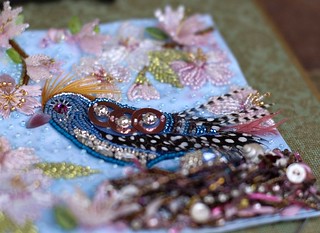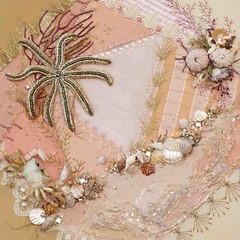I had expected that this blog would have posted two days ago and would be a tale of eight leaves. But after two days of work, it's a tale of four leaves.
In planning my work, I completely underestimated the amount of time it would take to work through the wiring and embroidering of theseeight four little leaves...
In planning my work, I completely underestimated the amount of time it would take to work through the wiring and embroidering of these
Fittingly, yesterday the Wall Street Journal published the article, "We Know Why You're Always Late."
According to the article, there are those who are chronically late and who suffer from a little-known concept called the Planning Fallacy, a tendency to consistently underestimate the time a task will take for completion.
Cue the sad face...That's me.
And that sad realization led me to reflect all day on the ideas put forth in the article and the challenge of blogging a creative life. Frankly, as many of my fellow blogging needle friends already know, it's tough to blog long-term embroidery projects (especially when they take years a long time). Sure, it's great to have the "TA-DA" post...the finished project in all its glory...but the reality of the creative process is that most days, progress is slow and just plain hard work.
That being said, the up-side of the work is that there are little tiny creative breakthroughs all the time.
When we are not slave to the clock, or a deadline or our own expectations, we are free to play, explore and experiment. And this, I believe, is where the real work is done.
Figuring out what you want to stitch is one task, figuring out how you are going to stitch it is quite another. For me, the stitching of the final product once I've figured out the how, takes the least amount of time.
Most of my time is spent in trial and error and it's where the bulk of my work takes place. I often gloss over this phase when blogging, failing to share its two-steps forward, three-steps back nature, and I jump directly to the final result e.g. eight finished leaves.
Indulge me and let me use these eight four leaves as an example. Last time I tried embroidering directly on fabric solvy and I didn't like the result. This time, I made a sandwich of fabri-solvy and organza so my embroidery had a stabilizer. I chose organza because I wanted my stabilizer to be as negligible as possible.
First, I couched wire to the underside of the leaves...

I couched wire to the underside of the leaves.
That statement is a perfect example of how I usually gloss over the minutiae. Here's what "I couched wire to the underside of the leaves" really means...
[I tried using two different sizes of wire and decided I like the look of the slightly larger SM size as opposed to the XSM. I tried couching with a YLI silk 100/3 thread in green and then using one strand of Gloriana brown floss to wrap the stems. I found that it was too bulky to stitch using those two threads so I decided to couch the stems in the brown floss and skip the green altogether. Next, I tried different numbers of couching stitches, trying to find the minimal number of couching stitches (which would be faster) while still getting the look I wanted on top. I decided I liked more because it gives me a straighter vein on the topside.]
Next, I started stitching the leaves.
[Which really means...I decided on using two strands of Tudor Silk floss. I stitched one leaf with one strand of Gloriana floss but its twist is looser than the Tudor silk and tends to fuzz out a bit, which I didn't like as much so I ripped it out. Once I decided on Tudor Silk, I played with different methods for using the variegated thread. I already had decided against using the fly stitch leaf method in last post so the two left most leaves were stitched by using the modified fishbone. I started stitching those leaves from top of leaf to bottom, alternating stitches as I went. Because of the variegated thread, that was giving me the effect where the color changes on the leaf traveled down the leaf evenly on either side. Next I tried muddling the leaf color by combining my two strands of floss in opposite directions which mean the colors were "pre-mixed" in the needle. That's the center leaf below and I liked that idea least of all. Lastly, I tried stitching my leaf using Separated Single Layer (which is the Japanese embroidery term for up one side and down the other leaving a one point open space for the vein). The effect of this stitch was to have the color variation travel up one side of the leaf and down the other which is shown on the leaf all the way to the right. This technique ends up showing off more of the vein so I need to make sure I couch my wires more carefully so they line up topside as I move forward.]
Well, if you're not asleep from reading all that detail, you'll see how iterative and time consuming the process can be.
Showing the result of four leaves in two days of work doesn't seem like much and gives a false idea of how much actual progress is being made. In reality, a TON of learning has taken place about types of stitches, about limitations of threads, about sizes of wires, about improved methods, etc.
In many respects, it's the same process that a writer goes through in choosing the right words, the right sentences. Whole days can go by where an author writes and re-writes the same paragraph over and over until it's just right. Writing a good book can take years.
And so it is with me.
I have a story to tell and I am choosing which threads and stitches and materials will best convey all that I have to say. Sure, there are dozens of ways to make rose leaves, many of them much quicker than the methods I am using.
But the process of carefully choosing and curating the process becomes part of the story itself.
In the next few days, I will dissolve these leaves in water, and my technique will likely change again based on the result.
I can get some idea of how it might look from the underside...
Already I can see where some refinement is needed in the wrapping of the stems.
So it goes.
It's all part of figuring out what to say and how to say it.
While I was working today, I was listening to this podcast thanks to Maria Popova's post today on my absolute favorite daily read, Brain Pickings.
Even though she's a writer, I felt like the words of Dani Shapiro were speaking directly to me...
When writers who are just starting out ask me when it gets easier, my answer is never. It never gets easier. I don’t want to scare them, so I rarely say more than that, but the truth is that, if anything, it gets harder. The writing life isn’t just filled with predictable uncertainties but with the awareness that we are always starting over again. That everything we ever write will be flawed. We may have written one book, or many, but all we know — if we know anything at all — is how to write the book we’re writing. All novels are failures. Perfection itself would be a failure. All we can hope is that we will fail better. That we won’t succumb to fear of the unknown. That we will not fall prey to the easy enchantments of repeating what may have worked in the past. I try to remember that the job — as well as the plight, and the unexpected joy — of the artist is to embrace uncertainty, to be sharpened and honed by it. To be birthed by it. Each time we come to the end of a piece of work, we have failed as we have leapt — spectacularly, brazenly — into the unknown.
Here's to failing better tomorrow.
Happy brazen leaping everyone!
























12 comments:
Love seeing your process. Mine is similar - lots of trial and error until I get the effect I'm after. There's a lot of joy in the learning process, especially when you finally crack the nut you are working on.
Love it! It's why i love your blog and your presentations. Thanks for sharing yourself!
Well now I know the "Late" factor..."Planning Fallacy". Susan I am always enamored with your posts...the way you write, the content, the photos/images and the details with which you pursue your artisan craft with needle and thread. I honestly do not know another soul who is so dedicated to learning and practicing the way you are. I find your work and stories to be incredibly interesting and thoughtful and mind-altering. I read and view every tiny little detail you describe over and over again and still I can not see the mishaps you see. Happy Brazen Leaping indeed...
Okay -- so I admit I skimmed through the detail...only to say a) your leaves are exquisite, however long they took to create; and b) there is another way to look at the "problem" -- are we (I say 'we' because I often fall prey to this...um..behaviour)...Are we underestimating the time it will take to accomplish a given task OR are we overestimating our ability to accomplish said task in the allotted time? Just askin'... ;-)
How I can relate to this!
Planning Fallacy ~ "Sure I can do (insert number of multiples that is at least twice what I can accomplish) by (insert date that is surely at least one week sooner than is realistic)! Struggling with this very thing this week!
Somehow, I never remember to account for research, learning, gathering the appropriate materials nor the actual time it will take to create something. Every step always takes longer than what I think it will! ALWAYS! To top it off, I'm a terrible procrastinator, and work best with a looming deadline... but rarely am able to meet those deadlines! You'd think after 50 some years, I'd have learned by now!
Your tiny leaves are exquisite and I cannot wait to see them in place with your perfect tiny roses! And thank you so much for sharing the details of your process! I loved reading them!
Lovely post. When reading a blog post, it isn't always obvious the work that has gone into it. I admire you're patience and determination, and of course, your exquisite work.
I think most of your readers understand about all the work you don't usually describe, but it's fascinating to have the extra details. After all, the experimentation is part of the fun...
I so very much enjoy your posts. I appreciate your talents, love your teaching and can't wait for the next visit.
I love your quote today! It made me laugh... and then wince a little. ;) Your rose leaves are beautiful and perfect after all your testing. Brilliant idea to couch from the bottom. Way to go, for thinking about a different approach to solving old problems in order to get the effect you want!
Lovely work and I do know the time it takes....have just spent 4 days embroidering french knots on a 'cherry tree'.....it was so laborious...glad it's over....never again.
Greetings from Northern Ireland.
http:www.craftyquills.blogspot.co.uk
This post has me thinking....can you imagine all the different directions the stitchers took to get the look right for those runway gowns you blogged? Granted, experienced stitchers will already know what works...but is that what the designer sees in his/her head? I wonder how many many days it took to get to the end result???
I experimented with using only variegated threads on what became a pillow top...it was a lot harder than I thought it would be!! So kudos to you!
Planning fallacy? Oh, yes, guilty. Love reading your posts--there's always something I learn or something that sparks contemplation.
Post a Comment